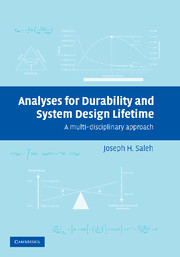Book contents
- Frontmatter
- Contents
- Preface
- 1 Introduction: On Time
- 2 To Reduce or to Extend Durability? A Qualitative Discussion of Issues at Stake
- 3 A Brief History of Economic Thought on Durability
- 4 Analysis of Marginal Cost of Durability and System Cost per Day
- 5 Flawed Metrics: System Cost per Day and Cost per Payload
- 6 Durability Choice and Optimal Design Lifetime for Complex Engineering Systems
- EPILOGUE: Perspectives in Design: The Deacon's Masterpiece and Hundred-Year Aircraft, Spacecraft, and Other Complex Engineering Systems
- APPENDIX A Beyond Cost Models, System Utility or Revenue Models: Example of a Communications Satellite
- APPENDIX B On Durability and Economic Depreciation
- Index
- References
APPENDIX B - On Durability and Economic Depreciation
Published online by Cambridge University Press: 25 October 2009
- Frontmatter
- Contents
- Preface
- 1 Introduction: On Time
- 2 To Reduce or to Extend Durability? A Qualitative Discussion of Issues at Stake
- 3 A Brief History of Economic Thought on Durability
- 4 Analysis of Marginal Cost of Durability and System Cost per Day
- 5 Flawed Metrics: System Cost per Day and Cost per Payload
- 6 Durability Choice and Optimal Design Lifetime for Complex Engineering Systems
- EPILOGUE: Perspectives in Design: The Deacon's Masterpiece and Hundred-Year Aircraft, Spacecraft, and Other Complex Engineering Systems
- APPENDIX A Beyond Cost Models, System Utility or Revenue Models: Example of a Communications Satellite
- APPENDIX B On Durability and Economic Depreciation
- Index
- References
Summary
PREVIEW AND GUIDE TO THE APPENDIX
Economic depreciation, or the decline in value of an asset with time, has traditionally been associated with the physical deterioration of a capital asset and its functional obsolescence. This Appendix advances two ideas. First, an understanding of depreciation need not be based on deterioration, wear and tear, or obsolescence. Instead, it is shown that the depreciation of a capital asset between two consecutive time periods is equal to the expected incremental present value of the services provided by the asset during this time interval. Second, this Appendix provides a framework for a dynamic forecast of depreciation – a forecast that can be updated and refined as the asset is put to service until its depreciation becomes observable in a resale market. The forecast horizon for depreciation ranges between the expected useful life of an asset and zero. In the latter case, the forecast becomes “observation.” Empirical studies of depreciation are a special case within the proposed framework, where the change in an asset's value is “observed” or measured in a resale market.
Introduction
Depreciation is an important concept for accountants, economists, and financial managers, and it has received significant attention in the literature. The focus in the economics literature has been to a large extent on empirical studies of economic depreciation. These empirical studies investigate aggregate depreciation for cohorts of assets, as opposed to the value trajectory of an individual asset as it ages.
- Type
- Chapter
- Information
- Analyses for Durability and System Design LifetimeA Multidisciplinary Approach, pp. 171 - 194Publisher: Cambridge University PressPrint publication year: 2007



